MNG82001 Reflective Case Study: Managing Conflict in Senior Leadership
VerifiedAdded on 2023/03/21
|7
|1871
|98
Case Study
AI Summary
This reflective case study examines a conflict between two senior leaders in a sports apparel company and how the CEO attempts to manage the situation. The case details the perspectives of various stakeholders and explores potential solutions, including team-building exercises, coaching, and aligned incentives. The study concludes by posing questions about how the CEO should handle the conflict and how the leaders can improve their relationship. The solution provides suggested strategies for Andrew to manage the conflict, emphasizing team collaboration and open communication. It also suggests how Shane and David can foster a better relationship by acknowledging shared goals, communicating effectively, and respecting each other's ideas. Desklib offers a variety of solved assignments and past papers to aid students in their studies.
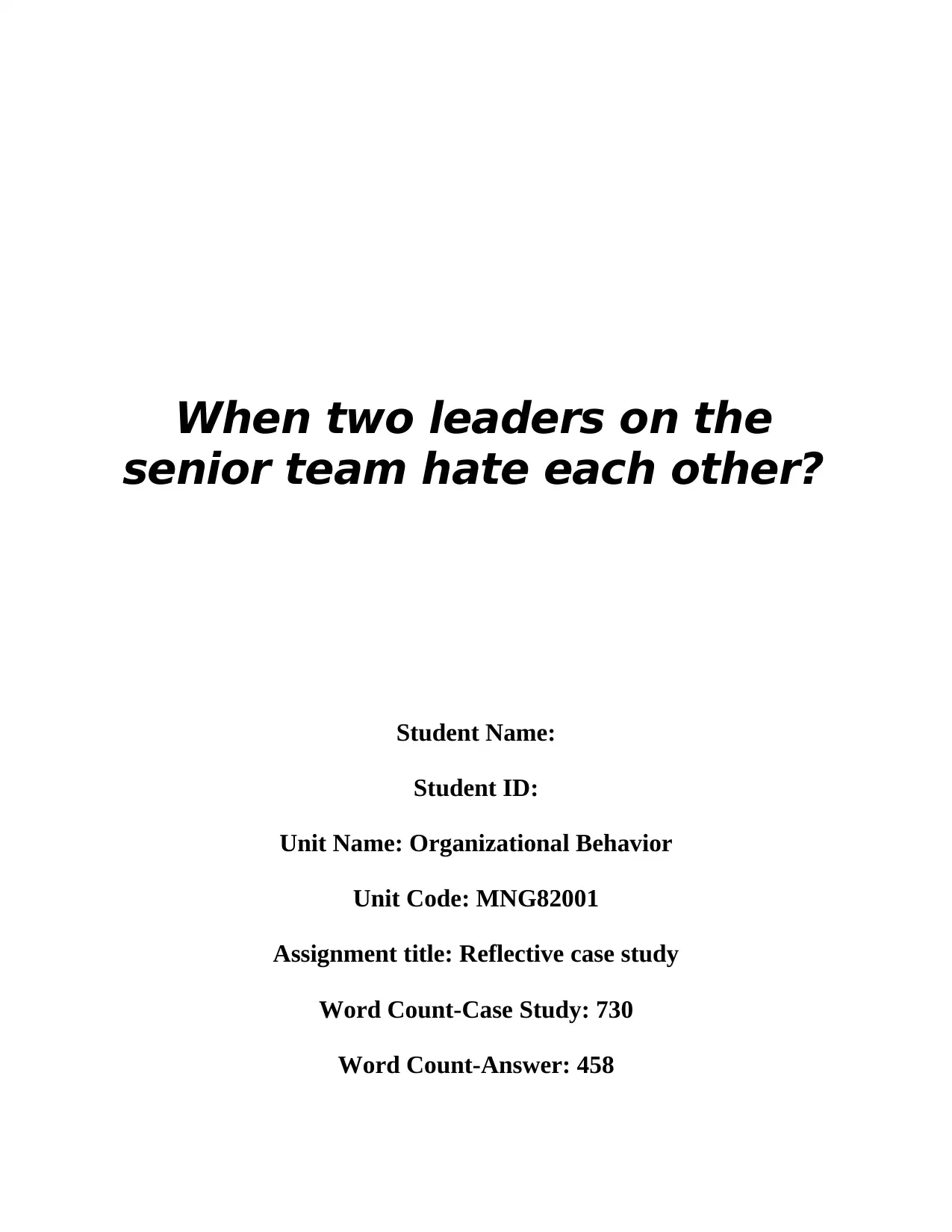
When two leaders on the
senior team hate each other?
Student Name:
Student ID:
Unit Name: Organizational Behavior
Unit Code: MNG82001
Assignment title: Reflective case study
Word Count-Case Study: 730
Word Count-Answer: 458
senior team hate each other?
Student Name:
Student ID:
Unit Name: Organizational Behavior
Unit Code: MNG82001
Assignment title: Reflective case study
Word Count-Case Study: 730
Word Count-Answer: 458
Paraphrase This Document
Need a fresh take? Get an instant paraphrase of this document with our AI Paraphraser
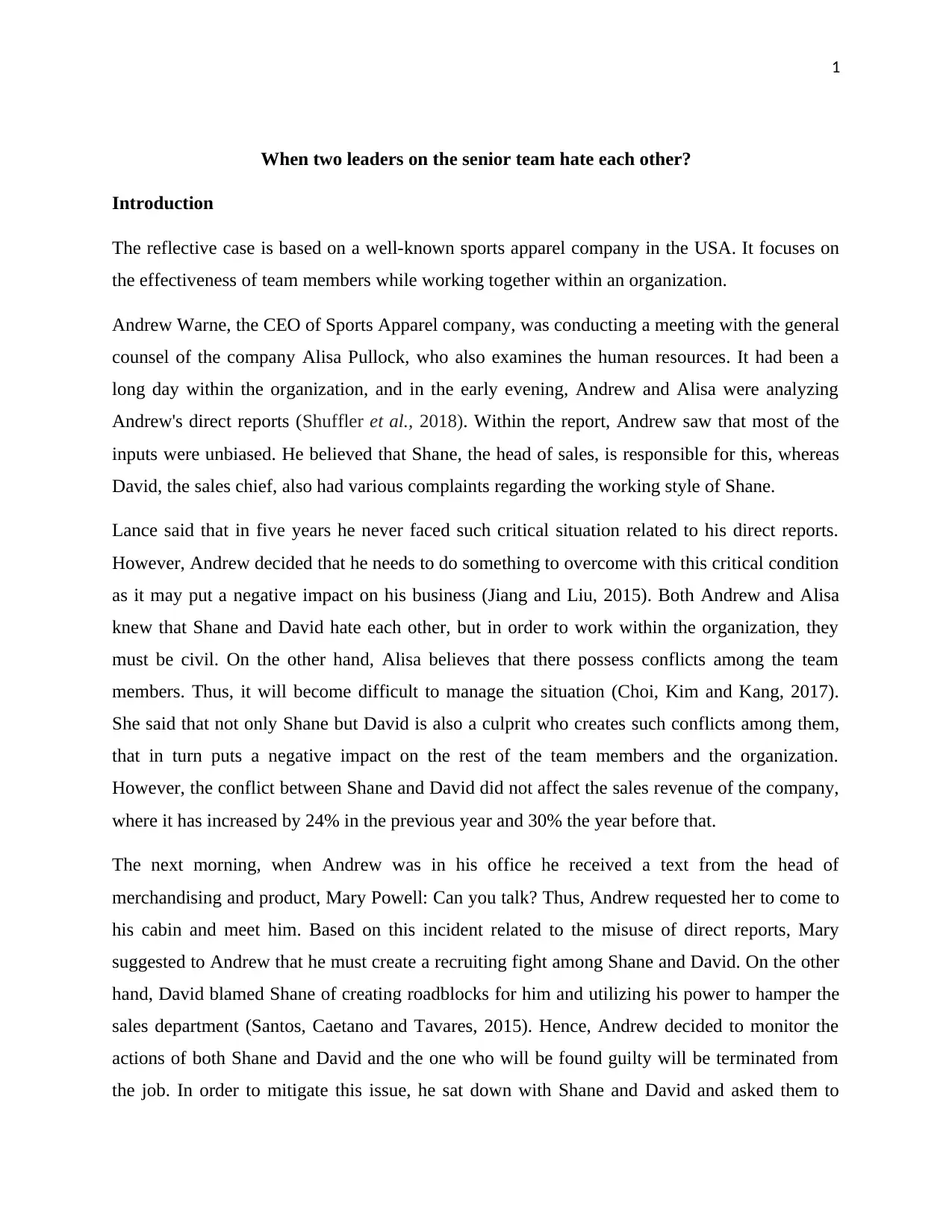
1
When two leaders on the senior team hate each other?
Introduction
The reflective case is based on a well-known sports apparel company in the USA. It focuses on
the effectiveness of team members while working together within an organization.
Andrew Warne, the CEO of Sports Apparel company, was conducting a meeting with the general
counsel of the company Alisa Pullock, who also examines the human resources. It had been a
long day within the organization, and in the early evening, Andrew and Alisa were analyzing
Andrew's direct reports (Shuffler et al., 2018). Within the report, Andrew saw that most of the
inputs were unbiased. He believed that Shane, the head of sales, is responsible for this, whereas
David, the sales chief, also had various complaints regarding the working style of Shane.
Lance said that in five years he never faced such critical situation related to his direct reports.
However, Andrew decided that he needs to do something to overcome with this critical condition
as it may put a negative impact on his business (Jiang and Liu, 2015). Both Andrew and Alisa
knew that Shane and David hate each other, but in order to work within the organization, they
must be civil. On the other hand, Alisa believes that there possess conflicts among the team
members. Thus, it will become difficult to manage the situation (Choi, Kim and Kang, 2017).
She said that not only Shane but David is also a culprit who creates such conflicts among them,
that in turn puts a negative impact on the rest of the team members and the organization.
However, the conflict between Shane and David did not affect the sales revenue of the company,
where it has increased by 24% in the previous year and 30% the year before that.
The next morning, when Andrew was in his office he received a text from the head of
merchandising and product, Mary Powell: Can you talk? Thus, Andrew requested her to come to
his cabin and meet him. Based on this incident related to the misuse of direct reports, Mary
suggested to Andrew that he must create a recruiting fight among Shane and David. On the other
hand, David blamed Shane of creating roadblocks for him and utilizing his power to hamper the
sales department (Santos, Caetano and Tavares, 2015). Hence, Andrew decided to monitor the
actions of both Shane and David and the one who will be found guilty will be terminated from
the job. In order to mitigate this issue, he sat down with Shane and David and asked them to
When two leaders on the senior team hate each other?
Introduction
The reflective case is based on a well-known sports apparel company in the USA. It focuses on
the effectiveness of team members while working together within an organization.
Andrew Warne, the CEO of Sports Apparel company, was conducting a meeting with the general
counsel of the company Alisa Pullock, who also examines the human resources. It had been a
long day within the organization, and in the early evening, Andrew and Alisa were analyzing
Andrew's direct reports (Shuffler et al., 2018). Within the report, Andrew saw that most of the
inputs were unbiased. He believed that Shane, the head of sales, is responsible for this, whereas
David, the sales chief, also had various complaints regarding the working style of Shane.
Lance said that in five years he never faced such critical situation related to his direct reports.
However, Andrew decided that he needs to do something to overcome with this critical condition
as it may put a negative impact on his business (Jiang and Liu, 2015). Both Andrew and Alisa
knew that Shane and David hate each other, but in order to work within the organization, they
must be civil. On the other hand, Alisa believes that there possess conflicts among the team
members. Thus, it will become difficult to manage the situation (Choi, Kim and Kang, 2017).
She said that not only Shane but David is also a culprit who creates such conflicts among them,
that in turn puts a negative impact on the rest of the team members and the organization.
However, the conflict between Shane and David did not affect the sales revenue of the company,
where it has increased by 24% in the previous year and 30% the year before that.
The next morning, when Andrew was in his office he received a text from the head of
merchandising and product, Mary Powell: Can you talk? Thus, Andrew requested her to come to
his cabin and meet him. Based on this incident related to the misuse of direct reports, Mary
suggested to Andrew that he must create a recruiting fight among Shane and David. On the other
hand, David blamed Shane of creating roadblocks for him and utilizing his power to hamper the
sales department (Santos, Caetano and Tavares, 2015). Hence, Andrew decided to monitor the
actions of both Shane and David and the one who will be found guilty will be terminated from
the job. In order to mitigate this issue, he sat down with Shane and David and asked them to
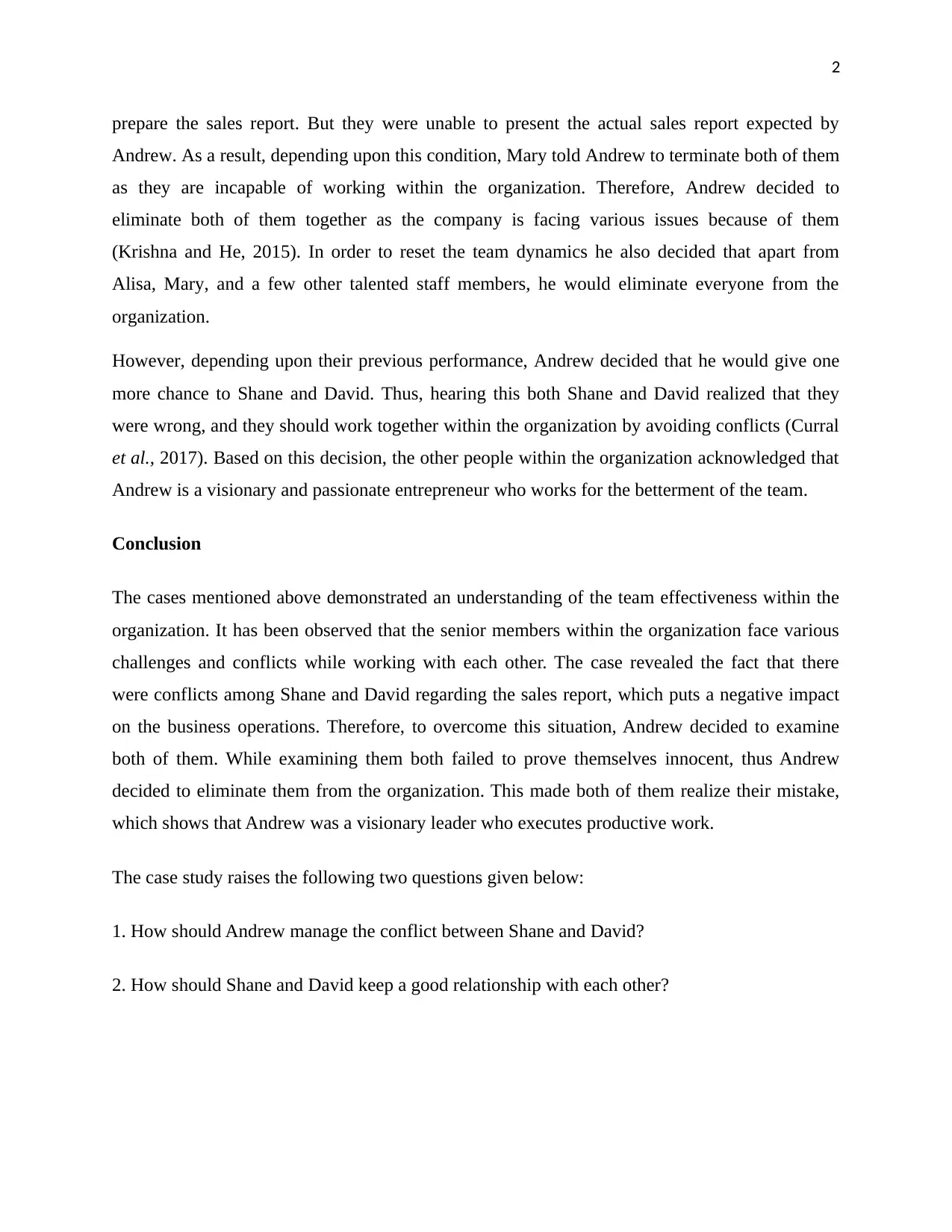
2
prepare the sales report. But they were unable to present the actual sales report expected by
Andrew. As a result, depending upon this condition, Mary told Andrew to terminate both of them
as they are incapable of working within the organization. Therefore, Andrew decided to
eliminate both of them together as the company is facing various issues because of them
(Krishna and He, 2015). In order to reset the team dynamics he also decided that apart from
Alisa, Mary, and a few other talented staff members, he would eliminate everyone from the
organization.
However, depending upon their previous performance, Andrew decided that he would give one
more chance to Shane and David. Thus, hearing this both Shane and David realized that they
were wrong, and they should work together within the organization by avoiding conflicts (Curral
et al., 2017). Based on this decision, the other people within the organization acknowledged that
Andrew is a visionary and passionate entrepreneur who works for the betterment of the team.
Conclusion
The cases mentioned above demonstrated an understanding of the team effectiveness within the
organization. It has been observed that the senior members within the organization face various
challenges and conflicts while working with each other. The case revealed the fact that there
were conflicts among Shane and David regarding the sales report, which puts a negative impact
on the business operations. Therefore, to overcome this situation, Andrew decided to examine
both of them. While examining them both failed to prove themselves innocent, thus Andrew
decided to eliminate them from the organization. This made both of them realize their mistake,
which shows that Andrew was a visionary leader who executes productive work.
The case study raises the following two questions given below:
1. How should Andrew manage the conflict between Shane and David?
2. How should Shane and David keep a good relationship with each other?
prepare the sales report. But they were unable to present the actual sales report expected by
Andrew. As a result, depending upon this condition, Mary told Andrew to terminate both of them
as they are incapable of working within the organization. Therefore, Andrew decided to
eliminate both of them together as the company is facing various issues because of them
(Krishna and He, 2015). In order to reset the team dynamics he also decided that apart from
Alisa, Mary, and a few other talented staff members, he would eliminate everyone from the
organization.
However, depending upon their previous performance, Andrew decided that he would give one
more chance to Shane and David. Thus, hearing this both Shane and David realized that they
were wrong, and they should work together within the organization by avoiding conflicts (Curral
et al., 2017). Based on this decision, the other people within the organization acknowledged that
Andrew is a visionary and passionate entrepreneur who works for the betterment of the team.
Conclusion
The cases mentioned above demonstrated an understanding of the team effectiveness within the
organization. It has been observed that the senior members within the organization face various
challenges and conflicts while working with each other. The case revealed the fact that there
were conflicts among Shane and David regarding the sales report, which puts a negative impact
on the business operations. Therefore, to overcome this situation, Andrew decided to examine
both of them. While examining them both failed to prove themselves innocent, thus Andrew
decided to eliminate them from the organization. This made both of them realize their mistake,
which shows that Andrew was a visionary leader who executes productive work.
The case study raises the following two questions given below:
1. How should Andrew manage the conflict between Shane and David?
2. How should Shane and David keep a good relationship with each other?
⊘ This is a preview!⊘
Do you want full access?
Subscribe today to unlock all pages.

Trusted by 1+ million students worldwide

3
Q 1. How should Andrew manage the conflict between Shane and David?
Ans: Andrew must focus more on the aspects such as team-building exercises, outside coaching,
and aligned incentives other than focusing upon the conflicts between Shane and David. I
recommend that Andrew must conduct biweekly staff meetings in order to discuss organizational
goals. On the other hand, rather than revamping the compensation, Andrew must work on a
project to collaborate with the other team members (Alsharo, Gregg & Ramirez, 2017). He must
encourage Shane and David to work together as a team member that will be beneficial for
themselves and the organization. He must motivate Shane and David along with other team
members for their better performance and appreciate them with reward. It is significant for
Andrew to examine and monitor the work performance of Shane and David and provide them
positive or negative feedback.
On the other hand, to manage the conflicts, he must consult with the general counsel, head of
HR, and sales chief to get relevant solutions. I suggest that he must enhance more C-suite
teamwork to minimize the tension arising among Shane and David. Andrew must have an open
conversation with Shane and David regarding their needs and wants (Reis and Puente-Palacios,
2019). This would help in making higher-quality decisions and avoiding conflicts. He must also
appoint an organizational coach and consultant who will identify and resolve the situation and
make appropriate recommendations.
Q 1. How should Andrew manage the conflict between Shane and David?
Ans: Andrew must focus more on the aspects such as team-building exercises, outside coaching,
and aligned incentives other than focusing upon the conflicts between Shane and David. I
recommend that Andrew must conduct biweekly staff meetings in order to discuss organizational
goals. On the other hand, rather than revamping the compensation, Andrew must work on a
project to collaborate with the other team members (Alsharo, Gregg & Ramirez, 2017). He must
encourage Shane and David to work together as a team member that will be beneficial for
themselves and the organization. He must motivate Shane and David along with other team
members for their better performance and appreciate them with reward. It is significant for
Andrew to examine and monitor the work performance of Shane and David and provide them
positive or negative feedback.
On the other hand, to manage the conflicts, he must consult with the general counsel, head of
HR, and sales chief to get relevant solutions. I suggest that he must enhance more C-suite
teamwork to minimize the tension arising among Shane and David. Andrew must have an open
conversation with Shane and David regarding their needs and wants (Reis and Puente-Palacios,
2019). This would help in making higher-quality decisions and avoiding conflicts. He must also
appoint an organizational coach and consultant who will identify and resolve the situation and
make appropriate recommendations.
Paraphrase This Document
Need a fresh take? Get an instant paraphrase of this document with our AI Paraphraser
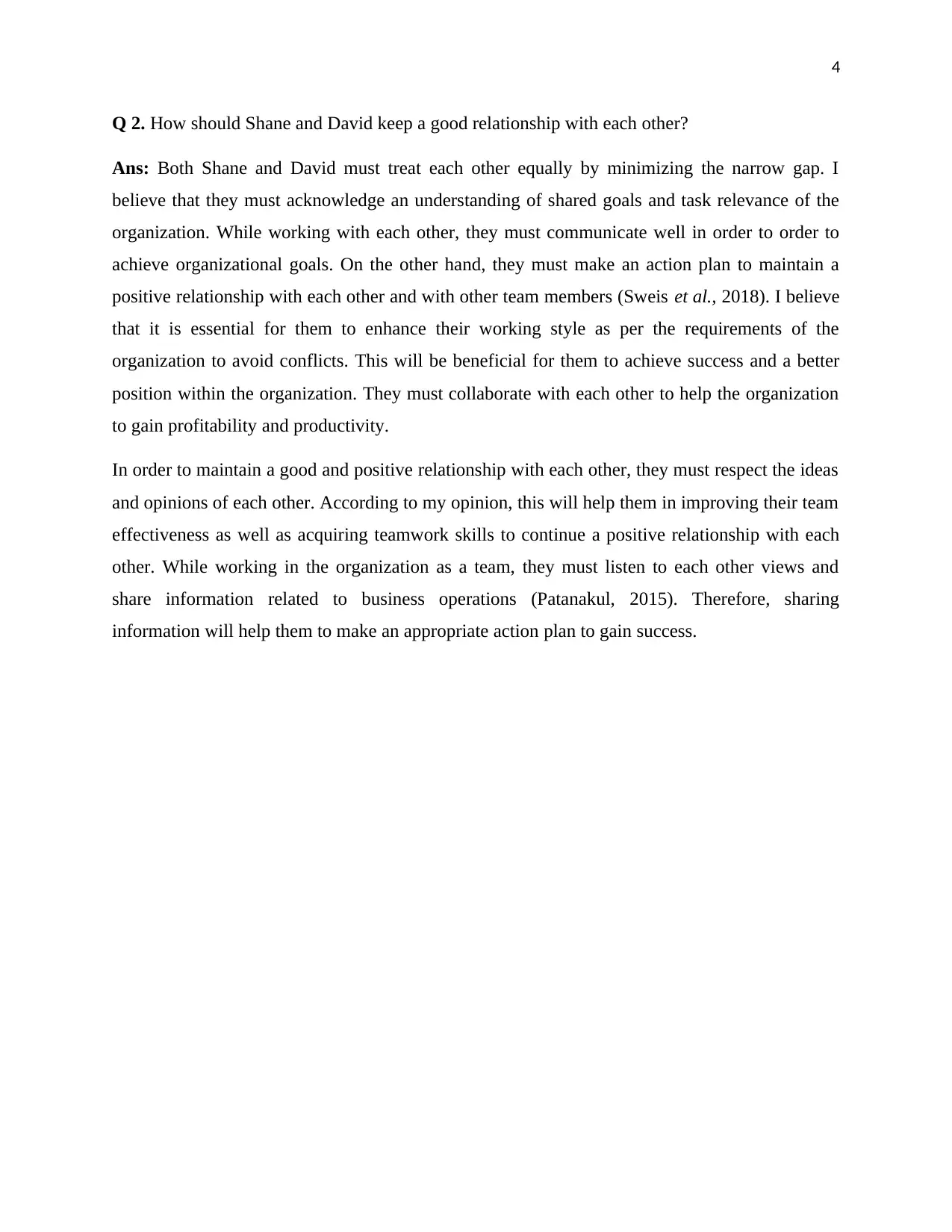
4
Q 2. How should Shane and David keep a good relationship with each other?
Ans: Both Shane and David must treat each other equally by minimizing the narrow gap. I
believe that they must acknowledge an understanding of shared goals and task relevance of the
organization. While working with each other, they must communicate well in order to order to
achieve organizational goals. On the other hand, they must make an action plan to maintain a
positive relationship with each other and with other team members (Sweis et al., 2018). I believe
that it is essential for them to enhance their working style as per the requirements of the
organization to avoid conflicts. This will be beneficial for them to achieve success and a better
position within the organization. They must collaborate with each other to help the organization
to gain profitability and productivity.
In order to maintain a good and positive relationship with each other, they must respect the ideas
and opinions of each other. According to my opinion, this will help them in improving their team
effectiveness as well as acquiring teamwork skills to continue a positive relationship with each
other. While working in the organization as a team, they must listen to each other views and
share information related to business operations (Patanakul, 2015). Therefore, sharing
information will help them to make an appropriate action plan to gain success.
Q 2. How should Shane and David keep a good relationship with each other?
Ans: Both Shane and David must treat each other equally by minimizing the narrow gap. I
believe that they must acknowledge an understanding of shared goals and task relevance of the
organization. While working with each other, they must communicate well in order to order to
achieve organizational goals. On the other hand, they must make an action plan to maintain a
positive relationship with each other and with other team members (Sweis et al., 2018). I believe
that it is essential for them to enhance their working style as per the requirements of the
organization to avoid conflicts. This will be beneficial for them to achieve success and a better
position within the organization. They must collaborate with each other to help the organization
to gain profitability and productivity.
In order to maintain a good and positive relationship with each other, they must respect the ideas
and opinions of each other. According to my opinion, this will help them in improving their team
effectiveness as well as acquiring teamwork skills to continue a positive relationship with each
other. While working in the organization as a team, they must listen to each other views and
share information related to business operations (Patanakul, 2015). Therefore, sharing
information will help them to make an appropriate action plan to gain success.
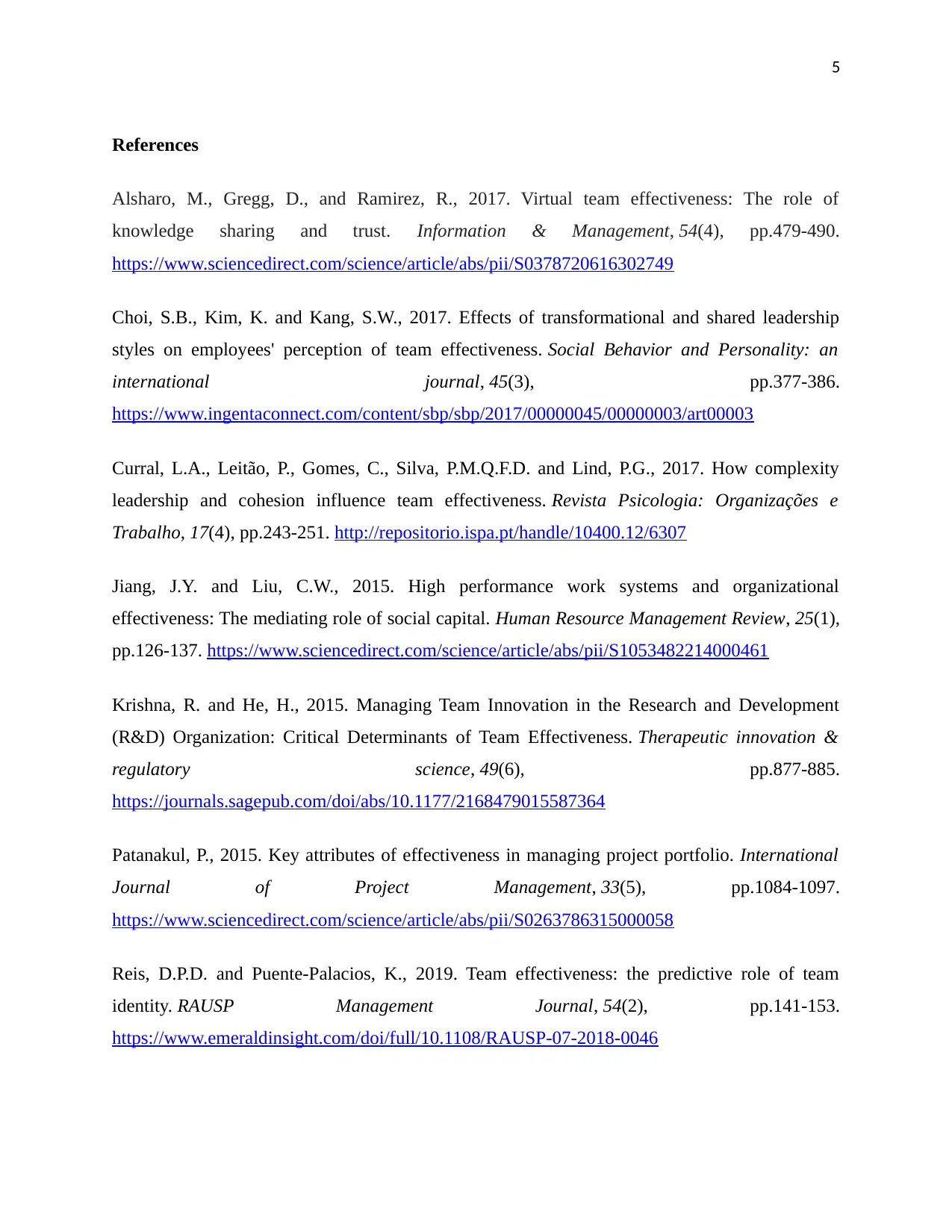
5
References
Alsharo, M., Gregg, D., and Ramirez, R., 2017. Virtual team effectiveness: The role of
knowledge sharing and trust. Information & Management, 54(4), pp.479-490.
https://www.sciencedirect.com/science/article/abs/pii/S0378720616302749
Choi, S.B., Kim, K. and Kang, S.W., 2017. Effects of transformational and shared leadership
styles on employees' perception of team effectiveness. Social Behavior and Personality: an
international journal, 45(3), pp.377-386.
https://www.ingentaconnect.com/content/sbp/sbp/2017/00000045/00000003/art00003
Curral, L.A., Leitão, P., Gomes, C., Silva, P.M.Q.F.D. and Lind, P.G., 2017. How complexity
leadership and cohesion influence team effectiveness. Revista Psicologia: Organizações e
Trabalho, 17(4), pp.243-251. http://repositorio.ispa.pt/handle/10400.12/6307
Jiang, J.Y. and Liu, C.W., 2015. High performance work systems and organizational
effectiveness: The mediating role of social capital. Human Resource Management Review, 25(1),
pp.126-137. https://www.sciencedirect.com/science/article/abs/pii/S1053482214000461
Krishna, R. and He, H., 2015. Managing Team Innovation in the Research and Development
(R&D) Organization: Critical Determinants of Team Effectiveness. Therapeutic innovation &
regulatory science, 49(6), pp.877-885.
https://journals.sagepub.com/doi/abs/10.1177/2168479015587364
Patanakul, P., 2015. Key attributes of effectiveness in managing project portfolio. International
Journal of Project Management, 33(5), pp.1084-1097.
https://www.sciencedirect.com/science/article/abs/pii/S0263786315000058
Reis, D.P.D. and Puente-Palacios, K., 2019. Team effectiveness: the predictive role of team
identity. RAUSP Management Journal, 54(2), pp.141-153.
https://www.emeraldinsight.com/doi/full/10.1108/RAUSP-07-2018-0046
References
Alsharo, M., Gregg, D., and Ramirez, R., 2017. Virtual team effectiveness: The role of
knowledge sharing and trust. Information & Management, 54(4), pp.479-490.
https://www.sciencedirect.com/science/article/abs/pii/S0378720616302749
Choi, S.B., Kim, K. and Kang, S.W., 2017. Effects of transformational and shared leadership
styles on employees' perception of team effectiveness. Social Behavior and Personality: an
international journal, 45(3), pp.377-386.
https://www.ingentaconnect.com/content/sbp/sbp/2017/00000045/00000003/art00003
Curral, L.A., Leitão, P., Gomes, C., Silva, P.M.Q.F.D. and Lind, P.G., 2017. How complexity
leadership and cohesion influence team effectiveness. Revista Psicologia: Organizações e
Trabalho, 17(4), pp.243-251. http://repositorio.ispa.pt/handle/10400.12/6307
Jiang, J.Y. and Liu, C.W., 2015. High performance work systems and organizational
effectiveness: The mediating role of social capital. Human Resource Management Review, 25(1),
pp.126-137. https://www.sciencedirect.com/science/article/abs/pii/S1053482214000461
Krishna, R. and He, H., 2015. Managing Team Innovation in the Research and Development
(R&D) Organization: Critical Determinants of Team Effectiveness. Therapeutic innovation &
regulatory science, 49(6), pp.877-885.
https://journals.sagepub.com/doi/abs/10.1177/2168479015587364
Patanakul, P., 2015. Key attributes of effectiveness in managing project portfolio. International
Journal of Project Management, 33(5), pp.1084-1097.
https://www.sciencedirect.com/science/article/abs/pii/S0263786315000058
Reis, D.P.D. and Puente-Palacios, K., 2019. Team effectiveness: the predictive role of team
identity. RAUSP Management Journal, 54(2), pp.141-153.
https://www.emeraldinsight.com/doi/full/10.1108/RAUSP-07-2018-0046
⊘ This is a preview!⊘
Do you want full access?
Subscribe today to unlock all pages.

Trusted by 1+ million students worldwide

6
Santos, J.P., Caetano, A. and Tavares, S.M., 2015. Is training leaders in functional leadership a
useful tool for improving the performance of leadership functions and team effectiveness?. The
Leadership Quarterly, 26(3), pp.470-484.
https://www.sciencedirect.com/science/article/pii/S1048984315000466
Shuffler, M.L., Diazgranados, D., Maynard, M.T., and Salas, E., 2018. Developing, sustaining,
and maximizing team effectiveness: An integrative, dynamic perspective of team development
interventions. Academy of Management Annals, 12(2), pp.688-724.
https://journals.aom.org/doi/abs/10.5465/annals.2016.0045
Sweis, R.J., Al Sharef, R., Jandali, D., Obeidat, B.Y. and Andrawes, N., 2018. The relationship
between project team members’ effectiveness and acknowledgment of talent: Team members’
perspective. International Journal of Construction Education and Research, 14(2), pp.141-160.
https://www.tandfonline.com/doi/abs/10.1080/15578771.2017.1356401
Santos, J.P., Caetano, A. and Tavares, S.M., 2015. Is training leaders in functional leadership a
useful tool for improving the performance of leadership functions and team effectiveness?. The
Leadership Quarterly, 26(3), pp.470-484.
https://www.sciencedirect.com/science/article/pii/S1048984315000466
Shuffler, M.L., Diazgranados, D., Maynard, M.T., and Salas, E., 2018. Developing, sustaining,
and maximizing team effectiveness: An integrative, dynamic perspective of team development
interventions. Academy of Management Annals, 12(2), pp.688-724.
https://journals.aom.org/doi/abs/10.5465/annals.2016.0045
Sweis, R.J., Al Sharef, R., Jandali, D., Obeidat, B.Y. and Andrawes, N., 2018. The relationship
between project team members’ effectiveness and acknowledgment of talent: Team members’
perspective. International Journal of Construction Education and Research, 14(2), pp.141-160.
https://www.tandfonline.com/doi/abs/10.1080/15578771.2017.1356401
1 out of 7
Related Documents
Your All-in-One AI-Powered Toolkit for Academic Success.
+13062052269
info@desklib.com
Available 24*7 on WhatsApp / Email
![[object Object]](/_next/static/media/star-bottom.7253800d.svg)
Unlock your academic potential
Copyright © 2020–2026 A2Z Services. All Rights Reserved. Developed and managed by ZUCOL.





